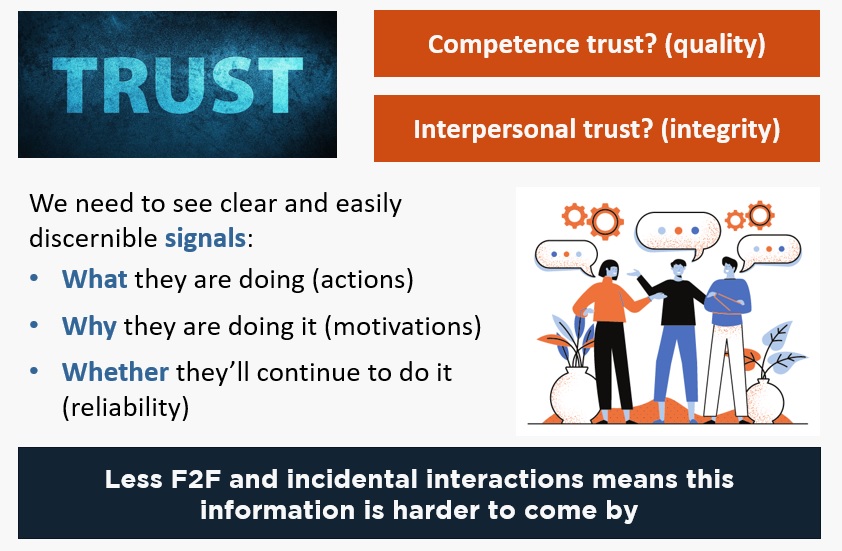Tips to help stop the erosion of trust that may come with hybrid ways of working
Navigating new ways of working is so topical right now in almost every single organisation in the world, and there is a flurry of information being shared that is so helpful to many about tips and traps, lessons and curiosities. On the back of sharing our ‘navigating ways of working’ blog earlier this month to those in our network, we were lucky to receive a return sharing from one of our clients who works in an organisation that is learning fast that managers must lead in different ways to the past. This February 2021 post from HBR, entitled ‘WFH is Corroding Our Trust in Each Other’ highlights that ‘while employees were willing to give one another some latitude earlier in the pandemic, now, almost a year in, their trust is wearing thin, and some find themselves wondering whether their remote employees are actually working at home.’

People feeling trusted is such a foundational need for people to be willing and able to be their best at work. If leaders don’t pay attention to ‘the trust issue’ they risk a decline in motivation and engagement, and it could get away from them more quickly than they realise.
This blog by Mark Mortensen and Heidi Gardner offers insights that have come from research into organisations from a wide range of industries.
- It identifies some of the reasons why trust is such an issue right now, both at an organisation and a human level.
- And it provides logical arguments for why the common approach to dealing with a decrease in trust (and increase in monitoring), is definitely NOT the answer!
Some of the points that resonated most with us
- Intuitively, predictability is the foundation of trust. We need to trust at 2 levels – both at the competence and at an interpersonal level. Less face-to-face opportunities mean the information by which we help determine if we trust someone is much harder to come by.

Often managers who feel a lowering of trust – even an imagined one – resort to some form of increased monitoring. But this is NOT the answer!
Instead try these things:
- Show your trustworthiness – recognise trust is bi-directional and reciprocal. Focus on actions that help strengthen trust in you! Sending this ‘signal’ will increase collective trust. Be brave and go first!
- Build a ‘trust staircase’ – build it incrementally. Start with lower risk things and get runs on the board.
- Engage in ‘status quo’ communication – with so much change and uncertainty, focus on sharing ‘what is not changing’. Let them know what they can count on, even when there is so much uncertainty to navigate.
- Assume one-size-fits-none trusting – we all have different approaches to trust. Some people are automatic trusters and some are evidence-based trusters. Take the time to see what they need and what you need!
It is crucial for people leaders to manage for outcomes and results, not to process, or steps to get it done. Resist the temptation to micro-manage. Have team members hold themselves accountable for their goals and have them report their progress and results to you. Autonomy and empowerment leads to accountability – and feeds trust!
Click here to find the original source of these ideas – it is worth the read!
Click here to see our previous posts about ‘Effective Management v Micro-management’
